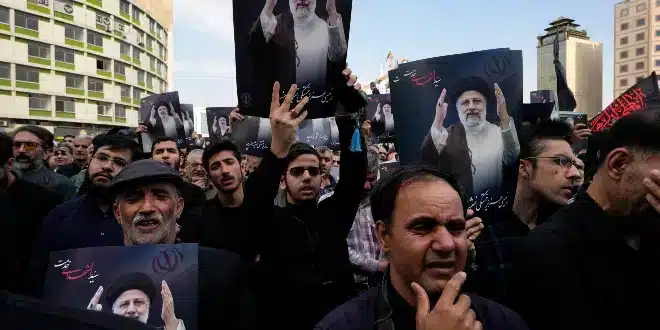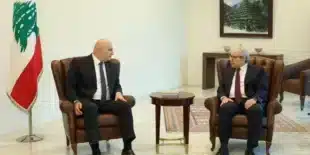Mourners dressed in black began assembling on Tuesday for the funerals and processions honoring Iran’s late president, foreign minister, and other officials who perished in a helicopter crash. These government-led ceremonies aim to both honor the deceased and project strength amidst an unsettled Middle East.
Mass demonstrations have been significant for Iran’s Shiite theocracy since millions welcomed Grand Ayatollah Ruhollah Khomeini during the 1979 Islamic Revolution, and attended his funeral ten years later. Similarly, an estimated one million people turned out in 2020 for processions for Revolutionary Guard General Qassem Soleimani, killed in a U.S. drone strike in Baghdad.
Whether President Ebrahim Raisi, Foreign Minister Hossein Amirabdollahian, and the others will draw the same large crowds is uncertain, particularly since Raisi died in a helicopter crash, won his office in the lowest-turnout presidential election in the country’s history, and led sweeping crackdowns on dissent. Prosecutors have already warned against public celebrations of his death, and a heavy security presence has been seen in Tehran since the crash.
Raisi, 63, was considered a potential successor to Iran’s supreme leader, Ayatollah Ali Khamenei, who is 85. Raisi’s death raises questions about the succession, especially with no clear heir-apparent for the presidency ahead of the June 28 elections.
“Raisi’s death comes at a moment when the Islamist regime is consolidated,” wrote Alex Vatanka, an Iran expert at the Middle East Institute. “There will be no power vacuum in Tehran; nonetheless, post-Khamenei Iran suddenly looks far less predictable than it did just a few days ago.”
A procession on Tuesday morning saw a semitruck carrying the caskets of the deceased move slowly through Tabriz, the city closest to the crash site. Thousands of mourners dressed in black walked alongside the coffins, throwing flowers and listening to an emcee weep for the men he described as martyrs.
The bodies will travel next to the holy Shiite city of Qom before reaching Tehran later on Tuesday. On Wednesday, a funeral presided over by Khamenei will also include a procession.
It is unclear what international presence the funeral will attract, as Raisi faced U.S. sanctions for his role in mass executions in 1988 and for targeting protesters and dissidents while leading the judiciary. Under Raisi, Iran also supplied bomb-carrying drones to Russia for its war in Ukraine.
“I don’t feel comfortable sending condolences while Iran is sending drones that are used against civilians in Ukraine,” wrote Lithuanian Foreign Minister Gabrielius Landsbergis on social media.
On Thursday, Raisi’s hometown of Birjand will host a procession, followed by a funeral and burial at the Imam Reza shrine in Mashhad, the only imam of the Shiite faith buried in Iran. This shrine, a center for pilgrims, has historically served as the burial site for Persian heroes, making it a rare and high honor.
Iran has declared five days of mourning, encouraging public attendance at the mourning sessions. Government employees and schoolchildren typically attend such events en masse, while others participate out of patriotism, curiosity, or a desire to witness historic events.
Rural populations in Iran often have a closer affinity to the Shiite faith and the government, whereas Tehran has long had a different view of Raisi and his policies, as seen in the mass protests that have shaken the capital for years.
The most recent protests were sparked by the 2022 death of Mahsa Amini, a woman detained over her allegedly loose headscarf, or hijab. The subsequent security crackdown resulted in over 500 deaths and 22,000 detentions. In March, a UN panel found that Iran was responsible for the “physical violence” leading to Amini’s death. Meanwhile, the Iranian rial has plummeted following the collapse of the nuclear deal with world powers, eroding people’s savings and pensions.
On Sunday night, as news of the helicopter crash spread, some chanted anti-government slogans, and fireworks were seen in parts of the capital. Critical messages and dark jokes about the crash circulated online.
Iran’s top prosecutor has ordered cases to be filed against those “publishing false content, lies and insults” against Raisi and others killed in the crash, according to ISNA news agency.
No cause has been provided by the government for the crash, which occurred in a foggy mountain range with a decades-old helicopter. Iranian presidents, including Mahmoud Ahmadinejad and Abolhasan Banisadr, have survived their own helicopter crashes while in office.
Iran’s military, not its civil aviation authority, will investigate and later report on the crash. Iran’s civil air crash investigators faced significant criticism over their reports on the downing of a Ukrainian passenger plane by an air defense battery in 2020 after Soleimani’s killing.
Meanwhile, the newly elected Assembly of Experts opened its first session on Tuesday. Both Raisi and the late Tabriz Friday leader Mohammad Ali Ale-Heshem were members. A flower-ringed portrait was placed on Raisi’s seat at the 88-member panel meeting, tasked with selecting the country’s next supreme leader. Iran’s acting President Mohammad Mokhber also attended.


